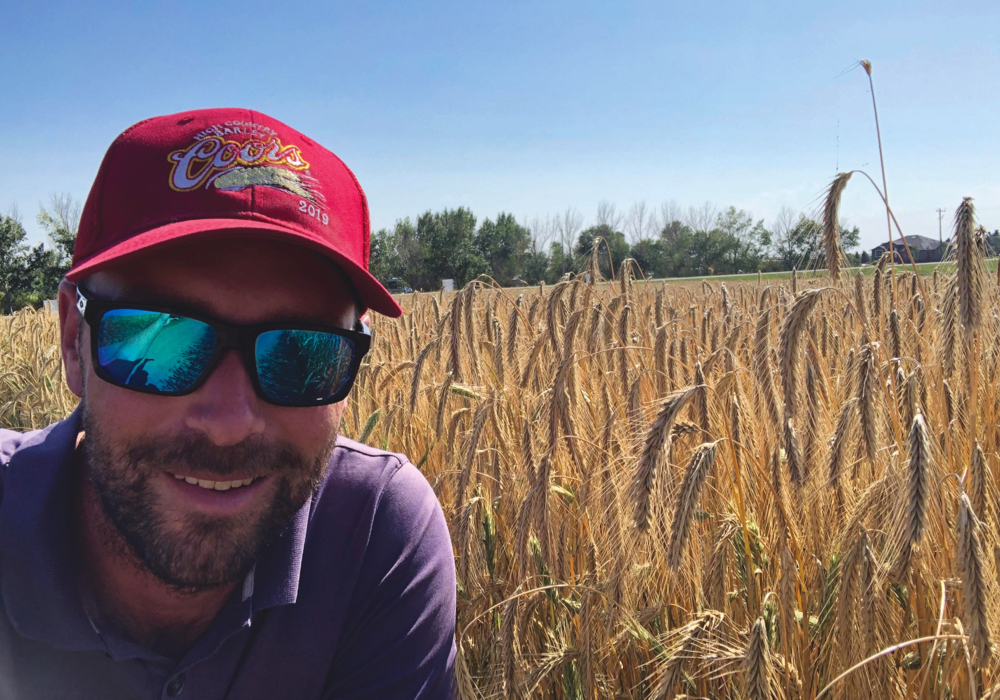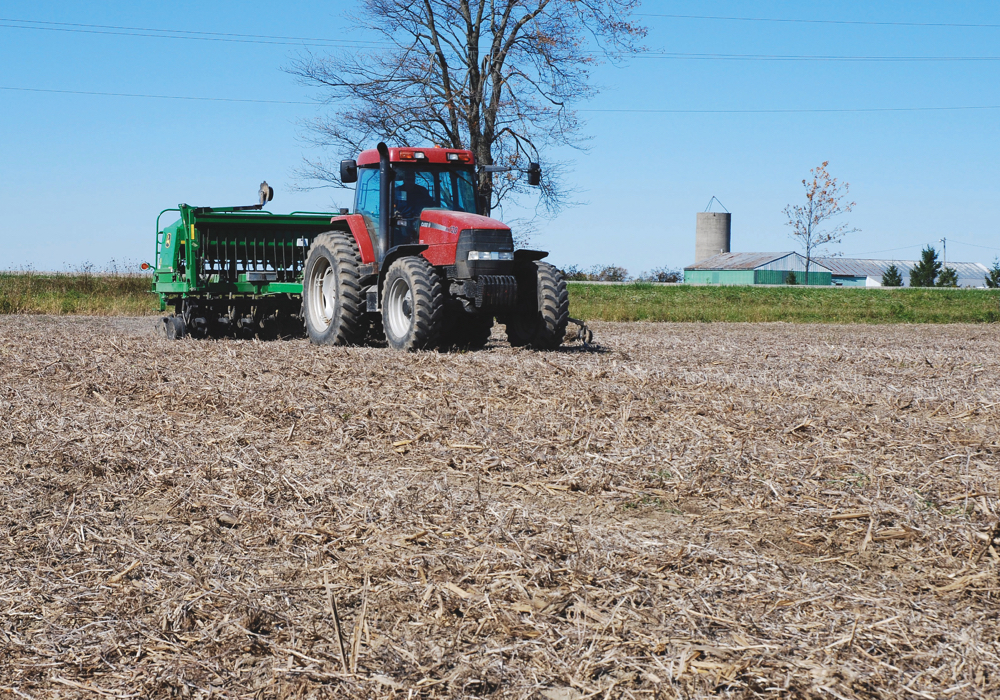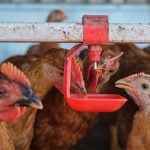Winter wheat’s challenges are well known. The crop has the most demanding planting season. Genetic gains in the past 25 years have been small relative to corn and soybeans. And most growers use some form of drill technology instead of a planter.
But that doesn’t mean the crop is stuck in neutral. Last fall saw the start of a research initiative into issues relating to plant stands in winter wheat, focusing on row spacing, seed spacing and seed depth. Although results have yet to be compiled, some intriguing directions have caught the attention of its two creators.
In late April, social media videos spread the trial’s early findings from four different planting treatments. Joanna Follings of the Ontario Ministry of Agriculture, Food and Rural Affairs (OMAFRA) and Peter Johnson from RealAgriculture, posted videos of their observations, testing the configurations on winter wheat planted into corn silage residue.
Read Also

Sensing the soil: Root cell research finds ‘stress hormone’
Research into how root cells react to soil stressors could help plants better adapt to changes in their climate.
The machines used in the four treatments included:
- a John Deere drill with SeederForce (from Middlesex Soil & Crop Improvement Association)
- a Bourgault drill, with technology similar to SeederForce (courtesy of Delta Farm Power)
- a John Deere drill (without down pressure) used on the Follings Farm, near Kitchener, Ont.
- an older Sunflower drill (also without down-pressure)
Follings and Johnson were clear. SeederForce (or similar down-force technologies) led to greater consistency in seed and row spacing.
Or, to put it the other way, seeding without down-force technology could be a mess. “We’d run into this situation where you’d have a bunch of plants clumped together, and I suspect it has to do with how the drill operates,” says Follings, OMAFRA’s cereal specialist
In fact, that’s a big part of the reason why the research was undertaken in the first place, she says. “We wanted to investigate the economics and how much yield you’d get if you were to upgrade your drill, purchase a new drill or bring in a custom operator to plant your wheat to ensure you get the best establishment.”
Wheat is one of the more responsive crops in terms of planting dates and fertility at planting, so establishment becomes one of the important metrics for improving yields. If there are issues with clumping and if there are clusters and gaps, how easy is it to solve the issue and improve yields? The research team started with down-force technology on a Bourgault drill. They also did some comparisons of conventional 7.5-inch drill spacing with and without fertility.
“In the drill we’d been using — a 10-inch Sunflower drill — there’s no seed singulation, no down-pressure, so when it came to emergence, there were quite a few gaps in plants and clumps in that treatment,” says Follings. “When we used down-pressure, it was amazing to see the uniformity of all the plants at emergence and after.”
That becomes useful later in the season with disease management and fusarium head blight, where there’s always been a concern with having a uniform crop for timing the fungicide. It’s not known yet how that will affect yield, but there is a definite benefit with consistency in seeding and depth of seeding.
Drilling down to the facts
Ask Peter Johnson about the issue with seeding and clumping of plants, and you’ll hear it’s 100 per cent machinery-induced. Johnson notes that the design of the fluted roller meter in a drill pushes out seeds in bunches.
Yet slowing the speed at planting likely isn’t a solution. Moving to a planter isn’t simple, either.
“The problem with a planter is twofold,” says Johnson. “First is the number of seeds. At 1.5 to 2.0 million wheat seeds versus 35,000 corn seeds even planter technology does not singulate seed well. And second, getting row units closer than 10-inch row widths is almost impossible.”
Follings and Johnson cite research by Drs. Manni Singh and Dennis Pennington at Michigan State University, comparing a Precision Planting unit with a 7.5-inch drill, finding less variation between plants using the former. The MSU research also tested a Monosem planter with specially designed plates that provided better singulation. The trade-off was a slower planting speed — down to 1.3 mph (2.0 kph) — but seed depth was vastly improved and clumping was also greatly reduced, even if overall spacing was only slightly better.
“When I look at clumped plants, I already know I have reduced yield potential,” says Johnson. “There’s also more disease, more lodging, less uniformity at heading, and clumps have so much plant-to-plant competition, the end result is not what we want.”
The wider the rows, he explains, the closer the seeds are together in the rows at any given population. Clumping may or may not be worse, but plant-to-plant competition increases as row width increases. With narrower row width, weed control is also improved.
“There are many considerations like available moisture, leaf architecture of the variety, field efficiency, equipment purchase costs and upkeep costs,” adds Johnson. “Manni and Dennis have excellent information on this and I’m surprised at how much yield they gained by moving to narrower rows. My own research over the years showed about a one per cent yield gain for every inch you move row widths closer.”
Seed depth is another overlooked factor, which Johnson believes to be a huge issue. It’s separate from bunching or clumping and is probably more important. Hoe drills in Western Canada have made strides in improving seed depth, and disc drills come closer but depths are still inconsistent.
Now Johnson would like to see similar research done here in Ontario.
Follings notes the MSU research also planted plots with 5-inch spacings. What she found interesting was the 10 per cent (roughly 10 bu./ac.) yield bump compared to 7.5 inches. That’s consistent with research in other regions of the world, including Europe, where they’re using narrower row spacing — down to 4.5- to 5-inch rows.
Although there is an advantage to narrower row-spacings for achieving higher yields, however, Follings maintains there’s also an advantage from the more recent technological advances in planter/seeder technologies.
“If you have a narrow row-spacing, you’re concentrating more seeds in a smaller area but then they’re actually able to capture more sunlight and more nutrients,” she says. “You don’t have any gaps in your stand and you’re maximizing resource capture when you have a thick, dense canopy while still giving each plant an opportunity to express itself.”
Other considerations
More advisors and agronomists are urging growers to apply the same practices to winter wheat as they do in corn and soybeans. As much as down-force or row-spacing may translate into higher yields, Follings appeals to getting back to basics, like optimal planting dates and adjusting soybean maturities on fields intended for wheat.
New research pegs the bushel-per-acre-per-day loss for late planting at 1.1 bushels (see the updated planting map for winter wheat at omafra.gov.on.ca).
“We put so much time and energy into ensuring our corn and soybeans are planted on time,” says Follings. “How many times will growers go over their planters to make sure everything’s ready to go or do some check strips before they get going. We don’t do that as much with wheat.”
Exception to the rule
Some growers have made the move to a planter for their winter wheat. For the past three years, for instance, Stephen Denys has put in 60 to 70 per cent of his wheat with his row planter, and 30 to 40 per cent via a custom air seeder.
“When I updated my planter to Precision V-Drives a few years back, I asked if they had wheat plates for this drive and the answer was ‘yes’, they were on their way to market,” says Denys, a grower from Chatham-Kent and director of market and product development with Maizex Seeds. “I’ve always thought with wheat there could be a yield advantage if we could do a better job of placement and spacing.”
That led Denys to a one-time investment in offset wheat plates for his Kinze planter, which he configures to eight 30-inch rows for corn and fifteen 15-inch rows for soybeans. His plan is to upgrade to a larger planter to accommodate wheat, with the key being the transfer of his Precision Planting systems to a larger machine to help defray the upfront costs.
“The primary advantages I see include seed placement and controlled planting depth,” says Denys. “I have a hydraulic down-pressure system on the planter, so I can set the depth and go across all soil types and be certain of the depth I am placing seed at.”
He also has a liquid fertilizer system on the planter for corn and white beans, and he recently added FlowSense sensors, which have helped ensure he’s close to the right rate for his investment in liquid fertilizer. Based on a small sample size of his own testing, Denys has found a disadvantage of 5 to 9 bushels in 15-inch rows versus 7.5-inch rows, which is why he doubles back to create 7.5-inch rows, maintaining accuracy using RTK-GPS.
If Denys has a concern, it’s that doubling back and the time, fuel and wear and tear on his equipment to do it. The electric drives on his planter can only go so fast metering out 1.6 million seeds per acre: anything faster than 5.1 mph (8 kph) results in a drop in population.
“But,” he says,“the offset’s there as I’m leveraging the investment already made in my row planter.”
















